Investigation of Cytotoxicity of Biosynthesized Colloidal Nanosilver against Local Leishmania tropica: In Vitro Study
Abstract
:1. Introduction
2. Materials and Methods
2.1. Materials
2.2. Synthesis of Silver Nanoparticles
2.3. Characterization of Silver Nanoparticles
2.4. Radical Scavenging Activity (DPPH)
2.5. Antileishmanial Activity
2.5.1. Culture of Leishmania Parasite
2.5.2. Cytotoxicity Assay on L. tropica Promastigotes
2.5.3. Data Processing and Statistics
3. Results and Discussion
3.1. UV-Vis Spectroscopy Analysis
3.1.1. Effect of AgNO3 Concentration
3.1.2. Effect of Volume Ratio of AEECL and Silver Nitrate
3.1.3. Effect of Reaction Time
3.2. Dynamic Light Scattering Analysis
3.3. Scanning Electron Microscopy and EDX Analysis
3.4. Atomic Force Microscopy Analysis
3.5. NTA Analysis
3.6. DPPH Assay for Antioxidant Activity
3.7. Anti-Promastigote Effect
4. Conclusions
Author Contributions
Funding
Institutional Review Board Statement
Informed Consent Statement
Conflicts of Interest
References
- World Health Organization Leishmaniasis. 2020. Available online: https://www.who.int/news-room/fact-sheets/detail/leishmaniasis (accessed on 30 March 2022).
- World Health Organization. WHO Addressing Leishmaniasis in High-Risk Areas of the Syrian Arab Republic. 2019. Available online: https://www.who.int/emergencies/crises/syr/news-features/leishmaniasis-in-high-risk-23july2019/en/ (accessed on 30 March 2022).
- Kato, K.C.; Morais-Teixeira, E.; Reis, P.G.; Silva-Barcellos, N.M.; Salaün, P.; Campos, P.P.; Corrêa-Junior, J.D.; Rabello, A.; Demicheli, C.; Frézard, F. Hepatotoxicity of Pentavalent Antimonial Drug: Possible Role of Residual Sb(III) and Protective Effect of Ascorbic Acid. Antimicrob. Agents Chemother. 2014, 58, 481–488. [Google Scholar] [CrossRef] [PubMed] [Green Version]
- Souto, E.B.; Dias-Ferreira, J.; Craveiro, S.A.; Severino, P.; Sanchez-Lopez, E.; Garcia, M.L.; Silva, A.M.; Souto, S.B.; Mahant, S. Therapeutic Interventions for Countering Leishmaniasis and Chagas’s Disease: From Traditional Sources to Nanotechnological Systems. Pathogens 2019, 8, 119. [Google Scholar] [CrossRef] [PubMed] [Green Version]
- Ponte-Sucre, A.; Gamarro, F.; Dujardin, J.-C.; Barrett, M.P.; López-Vélez, R.; García-Hernández, R.; Pountain, A.; Mwenechanya, R.; Papadopoulou, B. Drug resistance and treatment failure in leishmaniasis: A 21st century challenge. PLoS Negl. Trop. Dis. 2017, 11, e0006052. [Google Scholar] [CrossRef]
- Saleem, K.; Khursheed, Z.; Hano, C.; Anjum, I.; Anjum, S. Applications of Nanomaterials in Leishmaniasis: A Focus on Recent Advances and Challenges. Nanomaterials 2019, 9, 1749. [Google Scholar] [CrossRef] [Green Version]
- Akbari, M.; Oryan, A.; Hatam, G. Application of nanotechnology in treatment of leishmaniasis: A Review. Acta Trop. 2017, 172, 86–90. [Google Scholar] [CrossRef]
- Rajeshkumar, S.; Bharath, L.V.; Geetha, R. Broad spectrum antibacterial silver nanoparticle green synthesis: Characterization, and mechanism of action. In Green Synthesis, Characterization and Applications of Nanoparticles; Elsevier Inc.: Amsterdam, The Netherlands, 2019; pp. 429–444. [Google Scholar]
- Dung, T.T.N.; Nam, V.N.; Nhan, T.T.; Ngoc, T.T.B.; Minh, L.Q.; Nga, B.T.T.; Le, V.P.; Quang, D.V. Silver nanoparticles as potential antiviral agents against African swine fever virus. Mater. Res. Express 2019, 6, 1250g9. [Google Scholar] [CrossRef]
- Huang, W.; Yan, M.; Duan, H.; Bi, Y.; Cheng, X.; Yu, H. Synergistic Antifungal Activity of Green Synthesized Silver Nanoparticles and Epoxiconazole against Setosphaeria turcica. J. Nanomater. 2020, 2020, 9535432. [Google Scholar] [CrossRef] [Green Version]
- Burdușel, A.-C.; Gherasim, O.; Grumezescu, A.M.; Mogoantă, L.; Ficai, A.; Andronescu, E. Biomedical Applications of Silver Nanoparticles: An Up-to-Date Overview. Nanomaterials 2018, 8, 681. [Google Scholar] [CrossRef] [Green Version]
- Sivaranjana, P.; Nagarajan, E.; Rajini, N.; Ayrilmis, N.; Rajulu, A.V.; Siengchin, S. Preparation and characterization studies of modified cellulosic textile fabric composite with in situ-generated AgNPs coating. J. Ind. Text. 2019, 50, 1111–1126. [Google Scholar] [CrossRef]
- Zhang, Y.; Xu, J.; Chai, Y.; Zhang, J.; Hu, Z.; Zhou, H. Nano-silver modified porcine small intestinal submucosa for the treatment of infected partial-thickness burn wounds. Burns 2018, 45, 950–956. [Google Scholar] [CrossRef]
- Divya, M.; Kiran, G.S.; Hassan, S.; Selvin, J. Biogenic synthesis and effect of silver nanoparticles (AgNPs) to combat catheter-related urinary tract infections. Biocatal. Agric. Biotechnol. 2019, 8, 101037. [Google Scholar] [CrossRef]
- Azimijou, N.; Keshvari, H.; Tabaei, S.J.S.; Rahimi, M.; Imanzadeh, M. Investigation the effect of silver nanoparticles and bioresonance wave radiation on leishmania major: An in vitro study. J. Appl. Biotechnol. Rep. 2020, 7, 53–58. [Google Scholar] [CrossRef]
- Awad, M.A.; al Olayan, E.M.; Siddiqui, M.I.; Merghani, N.M.; Alsaif, S.S.A.; Aloufi, A.S. Antileishmanial effect of silver nanoparticles: Green synthesis, characterization, in vivo and in vitro assessmen. Biomed. Pharmacother. 2020, 137, 111294. [Google Scholar] [CrossRef] [PubMed]
- Vaseghi, Z.; Nematollahzadeh, A.; Tavakoli, O. Green methods for the synthesis of metal nanoparticles using biogenic reducing agents: A review. Rev. Chem. Eng. 2017, 34, 529–559. [Google Scholar] [CrossRef]
- Siddiqi, K.S.; Husen, A.; Rao, R.A.K. A review on biosynthesis of silver nanoparticles and their biocidal properties. J. Nanobiotechnol. 2018, 16, 14. [Google Scholar] [CrossRef]
- Shu, M.; He, F.; Li, Z.; Zhu, X.; Ma, Y.; Zhou, Z.; Yang, Z.; Gao, F.; Zeng, M. Biosynthesis and Antibacterial Activity of Silver Nanoparticles Using Yeast Extract as Reducing and Capping Agents. Nanoscale Res. Lett. 2020, 15, 14. [Google Scholar] [CrossRef] [Green Version]
- Shahzad, A.; Saeed, H.; Iqtedar, M.; Hussain, S.Z.; Kaleem, A.; Abdullah, R.; Sharif, S.; Naz, S.; Saleem, F.; Aihetasham, A.; et al. Size-Controlled Production of Silver Nanoparticles by Aspergillus fumigatus BTCB10: Likely Antibacterial and Cytotoxic Effects. J. Nanomater. 2019, 2019, 5168698. [Google Scholar] [CrossRef] [Green Version]
- Baltazar-Encarnación, E.; Escárcega-González, C.E.; Vasto-Anzaldo, X.G.; Cantú-Cárdenas, M.E.; Morones-Ramírez, J.R. Silver Nanoparticles Synthesized through Green Methods Using Escherichia coli Top 10 (Ec-Ts) Growth Culture Medium Exhibit Antimicrobial Properties against Nongrowing Bacterial Strains. J. Nanomater. 2019, 2019, 4637325. [Google Scholar] [CrossRef] [Green Version]
- John, T.; Parmar, K.A.; Tak, P. Biosynthesis and Characterization of Silver Nanoparticles from Tinospora cordifolia Root Extract. J. Nanosci. Technol. 2019, 5, 622–626. [Google Scholar] [CrossRef]
- Surya, S.; Kumar, G.D.; Rajakumar, R. Green Synthesis of Silver Nanoparticles from Flower Extract of Hibiscus rosa-sinensis and Its Antibacterial Activity. Int. J. Innov. Res. Sci. Eng. Technol. 2007, 15, 4523–4540. [Google Scholar] [CrossRef]
- Ping, Y.; Zhang, J.; Xing, T.; Chen, G.; Tao, R.; Choo, K.-H. Green synthesis of silver nanoparticles using grape seed extract and their application for reductive catalysis of Direct Orange 26. J. Ind. Eng. Chem. 2017, 58, 74–79. [Google Scholar] [CrossRef]
- Devanesan, S.; AlSalhi, M.S.; Balaji, R.V.; A Ranjitsingh, A.J.; Ahamed, A.; A Alfuraydi, A.; AlQahtani, F.Y.; Aleanizy, F.S.; Othman, A.H. Antimicrobial and Cytotoxicity Effects of Synthesized Silver Nanoparticles from Punica granatum Peel Extract. Nanoscale Res. Lett. 2018, 13, 315. [Google Scholar] [CrossRef] [PubMed] [Green Version]
- El-Khadragy, M.; Alolayan, E.M.; Metwally, D.M.; El-Din, M.F.S.; Alobud, S.S.; Alsultan, N.I.; Alsaif, S.S.; Awad, M.A.; Moneim, A.E.A. Clinical Efficacy Associated with Enhanced Antioxidant Enzyme Activities of Silver Nanoparticles Biosynthesized Using Moringa oleifera Leaf Extract, Against Cutaneous Leishmaniasis in a Murine Model of Leishmania major. Int. J. Environ. Res. Public Health 2018, 15, 1037. [Google Scholar] [CrossRef] [PubMed] [Green Version]
- Mohammed, O.T.; Abdulkhaliq, R.J.; Mohammed, S.T. The effects of Fusarium graminarum silver nanoparticles on Leishmania tropica. J. Phys. Conf. Ser. 2019, 1294, 062075. [Google Scholar] [CrossRef]
- Ullah, I.; Cosar, G.; Abamor, E.S.; Bagirova, M.; Shinwari, Z.K.; Allahverdiyev, A.M. Comparative study on the antileishmanial activities of chemically and biologically synthesized silver nanoparticles (AgNPs). 3 Biotech 2018, 8, 98. [Google Scholar] [CrossRef]
- Hashemi, Z.; Shirzadi-Ahoodashti, M.; Ebrahimzadeh, M.A. Antileishmanial and antibacterial activities of biologically synthesized silver nanoparticles using alcea rosea extract (Ar@ agnps). J. Water Environ. Nanotechnol. 2021, 6, 265–276. [Google Scholar] [CrossRef]
- Sabo, V.A.; Knezevic, P. Antimicrobial activity of Eucalyptus camaldulensis Dehn. plant extracts and essential oils: A review. Ind. Crop. Prod. 2019, 132, 413–429. [Google Scholar] [CrossRef]
- Elgat, W.A.A.; Kordy, A.M.; Böhm, M.; Černý, R.; Abdel-Megeed, A.; Salem, M.Z. Eucalyptus camaldulensis, Citrus aurantium, and Citrus sinensis Essential Oils as Antifungal Activity against Aspergillus flavus, Aspergillus niger, Aspergillus terreus, and Fusarium culmorum. Processes 2020, 8, 1003. [Google Scholar] [CrossRef]
- Nwabor, O.F.; Vongkamjan, K.; Voravuthikunchai, S.P. Antioxidant Properties and Antibacterial Effects of Eucalyptus camaldulensis Ethanolic Leaf Extract on Biofilm Formation, Motility, Hemolysin Production, and Cell Membrane of the Foodborne Pathogen Listeria monocytogenes. Foodborne Pathog. Dis. 2019, 16, 581–589. [Google Scholar] [CrossRef]
- Jarallah, H.M.; Hubash, A.H.; Jassim, A.-M.H. Effect of Eucalyptus Camaldulensis Extracts on Leishmania major In Vitro and In Vivo. Der Pharma Chem. 2017, 9, 131–136. [Google Scholar]
- Nosratabadi, S.J.; Sharifi, I.; Sharififar, F.; Bamorovat, M.; Daneshvar, H.; Mirzaie, M. In vitro antileishmanial activity of methanolic and aqueous extracts of Eucalyptus camaldulensis against Leishmania major. J. Parasit. Dis. 2013, 39, 18–21. [Google Scholar] [CrossRef] [PubMed] [Green Version]
- Zein, R.; Alghoraibi, I.; Soukkarieh, C.; Salman, A.; Alahmad, A. In-vitro anticancer activity against Caco-2 cell line of colloidal nano silver synthesized using aqueous extract of Eucalyptus Camaldulensis leaves. Heliyon 2020, 6, e04594. [Google Scholar] [CrossRef] [PubMed]
- Li, F.; Jin, H.; Xiao, J.; Yin, X.; Liu, X.; Li, D.; Huang, Q. The simultaneous loading of catechin and quercetin on chitosan-based nanoparticles as effective antioxidant and antibacterial agent. Food Res. Int. 2018, 111, 351–360. [Google Scholar] [CrossRef] [PubMed]
- Ibrahim, E.; Kilany, M.; Ghramh, H.A.; Khan, K.; Islam, S.U. Cellular proliferation/cytotoxicity and antimicrobial potentials of green synthesized silver nanoparticles (AgNPs) using Juniperus procera. Saudi J. Biol. Sci. 2018, 26, 1689–1694. [Google Scholar] [CrossRef]
- Ihsan, M.; Niaz, A.; Rahim, A.; Zaman, M.I.; Arain, M.B.; Sirajuddin; Sharif, T.; Najeeb, M. Biologically synthesized silver nanoparticle-based colorimetric sensor for the selective detection of Zn2+. RSC Adv. 2015, 5, 91158–91165. [Google Scholar] [CrossRef]
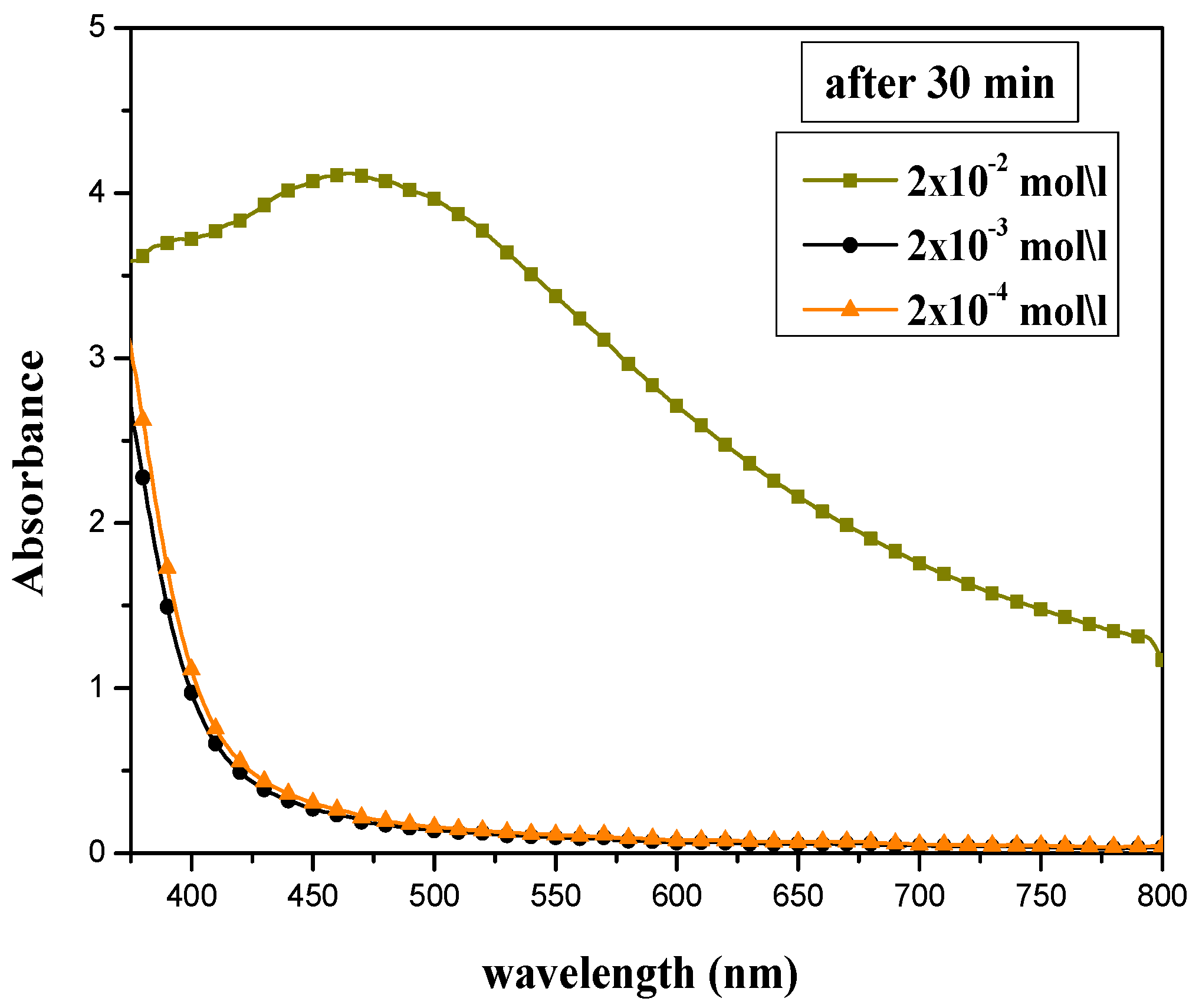
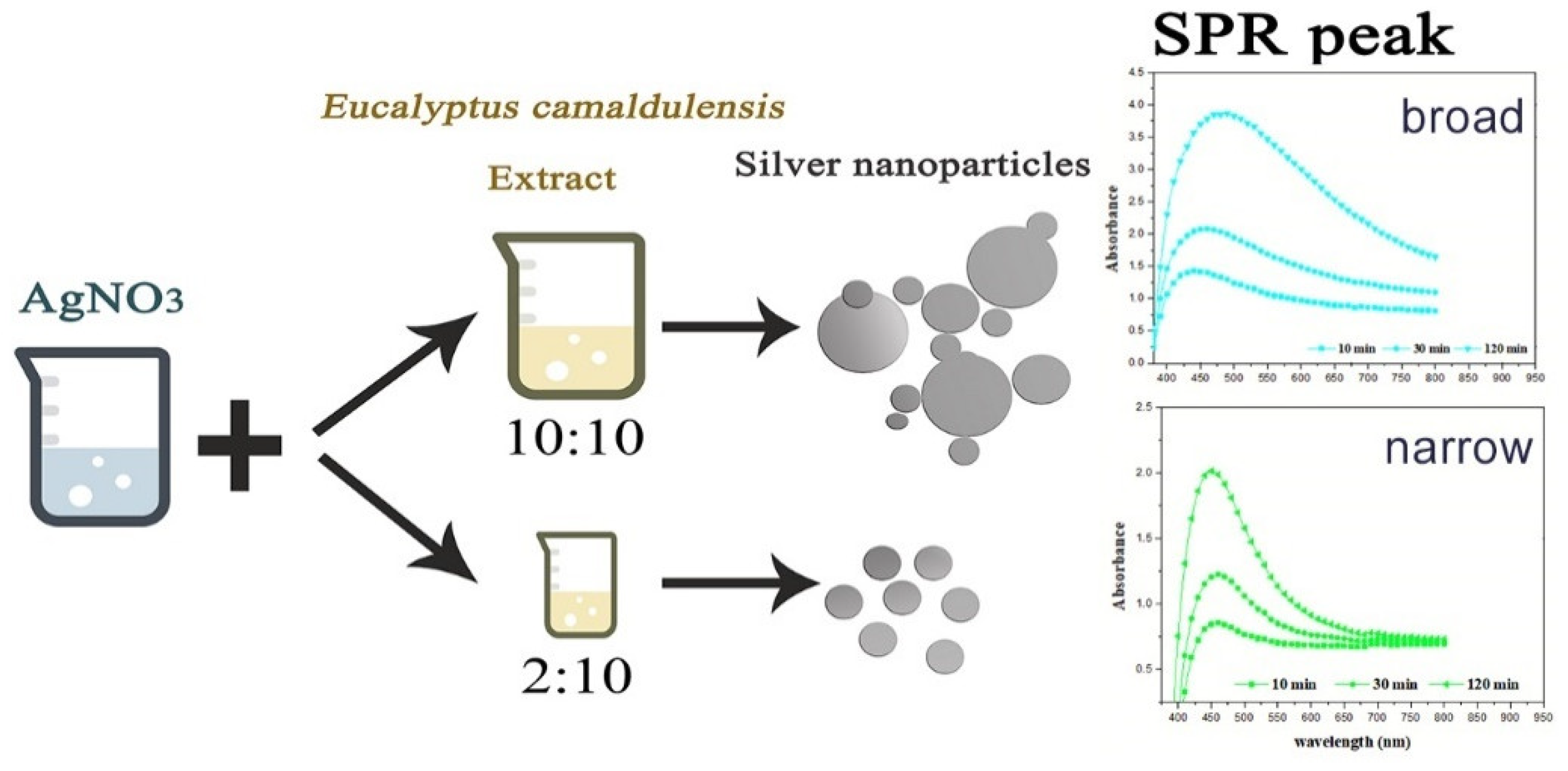
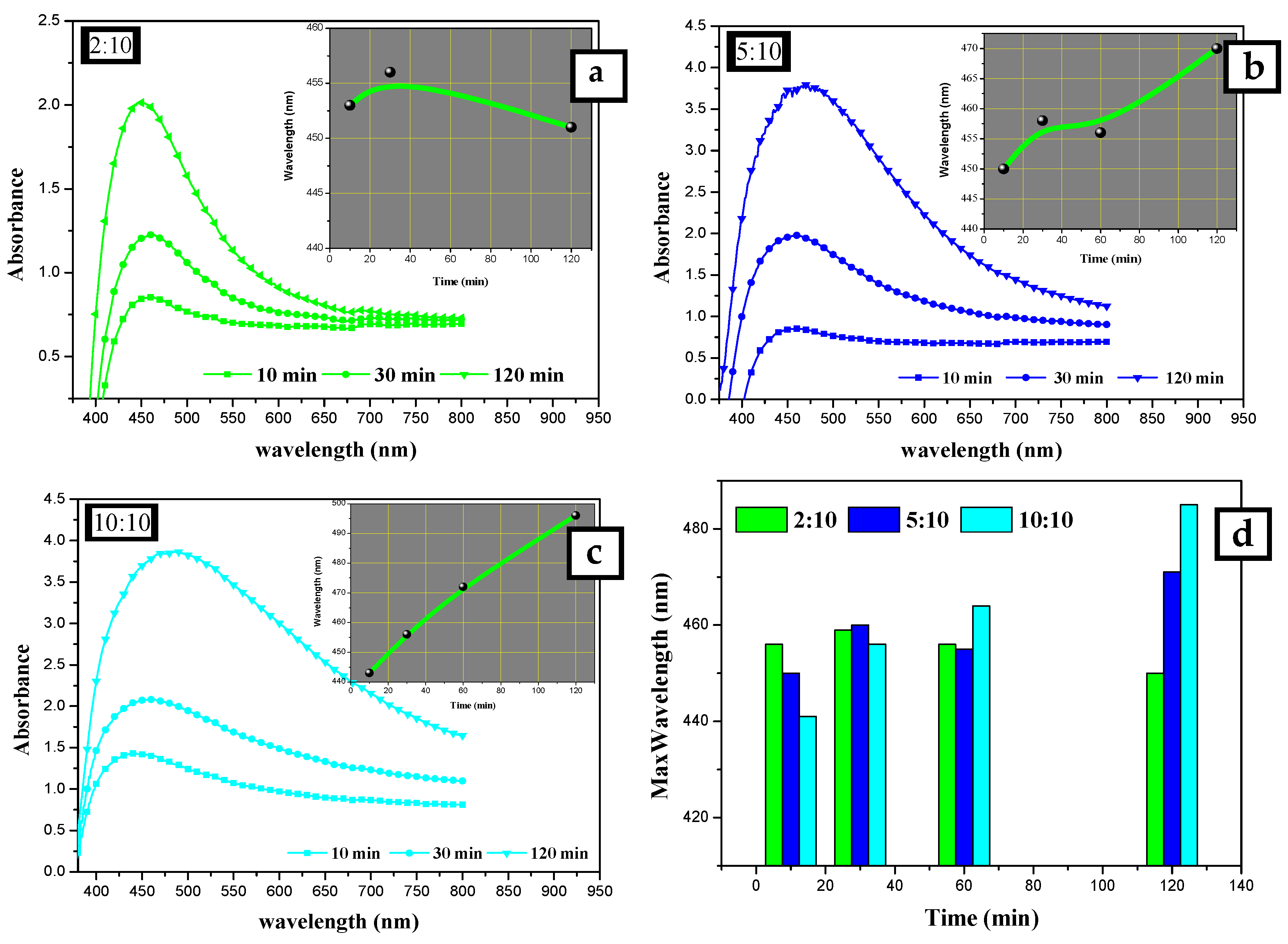





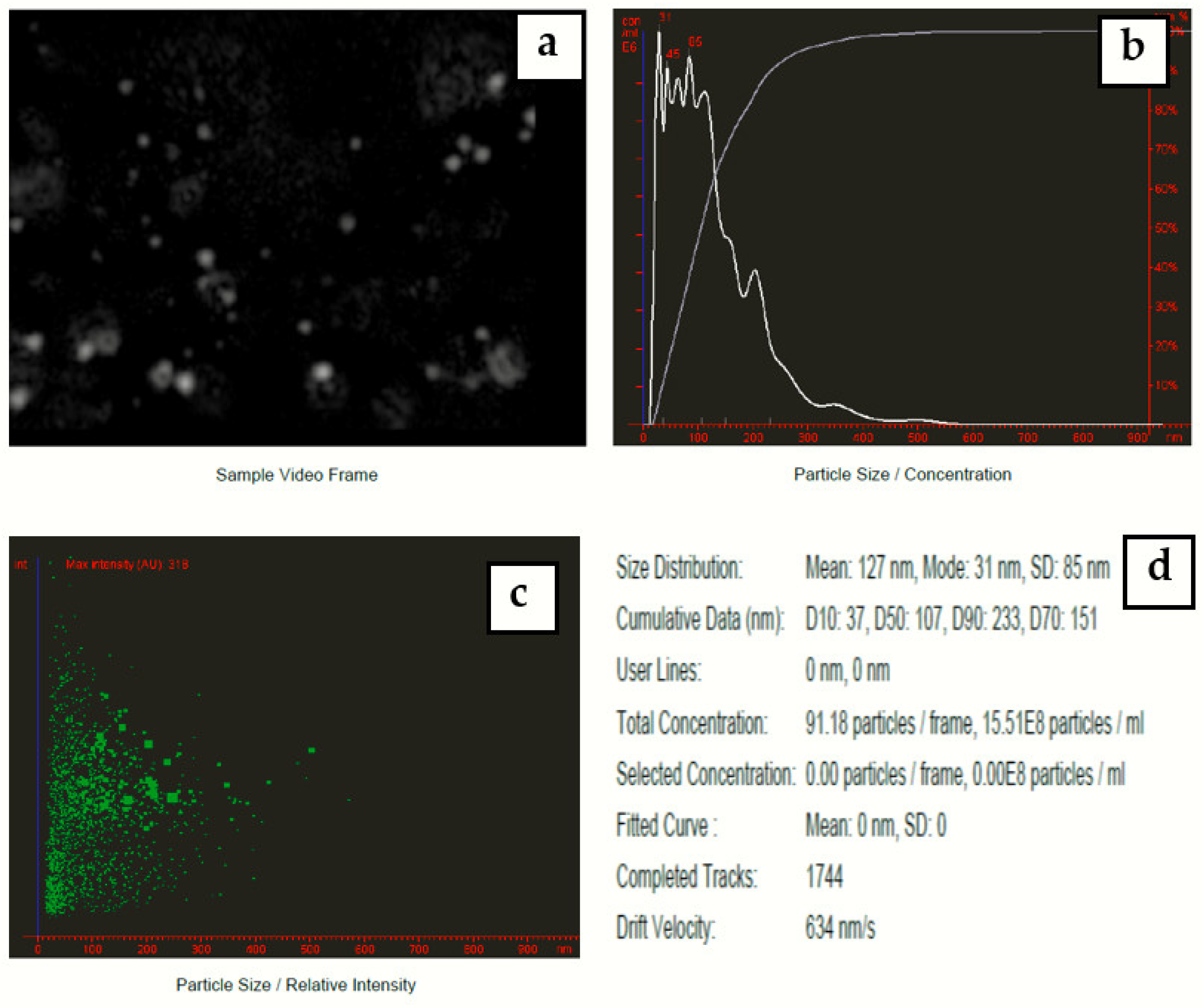
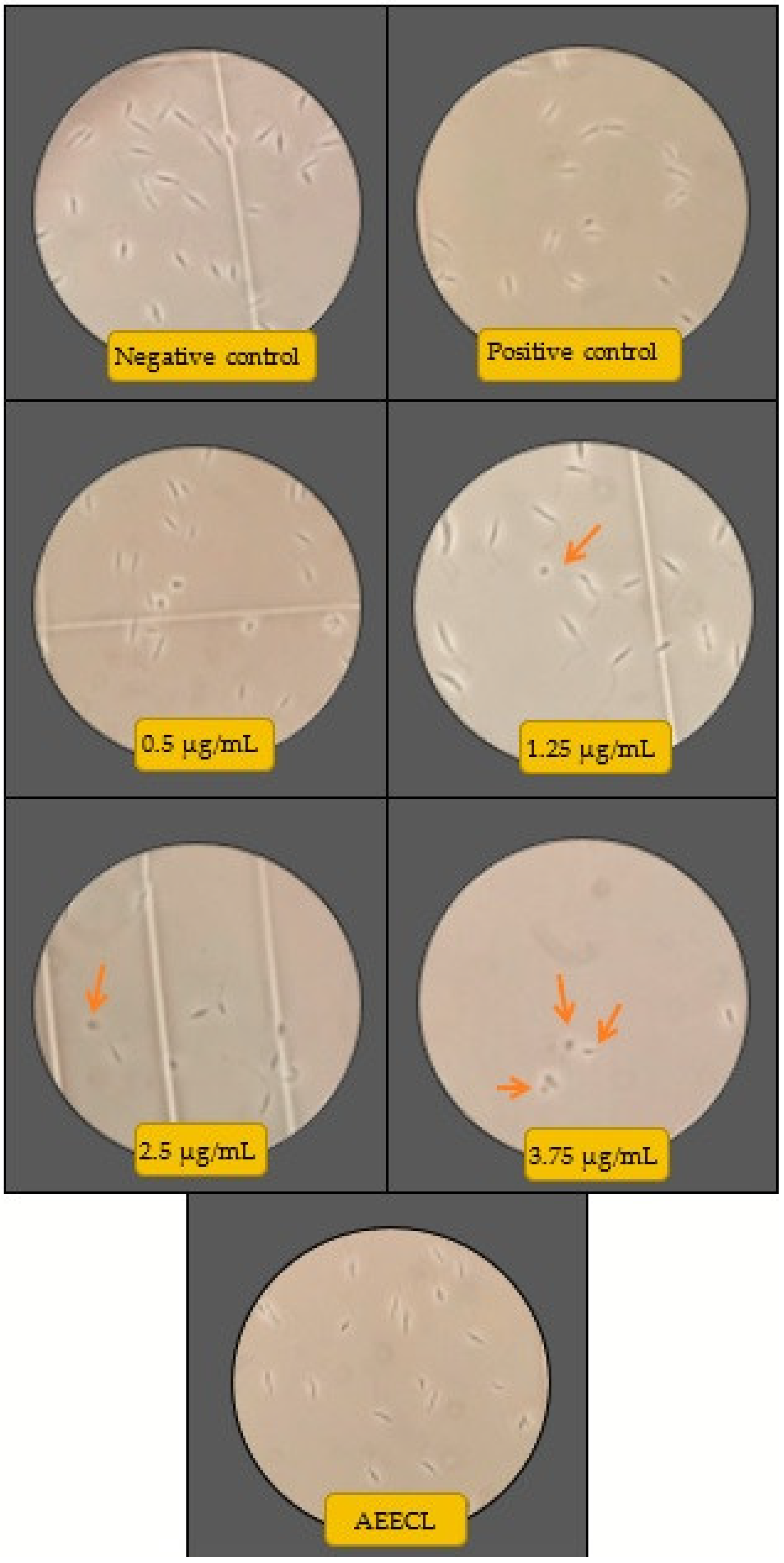
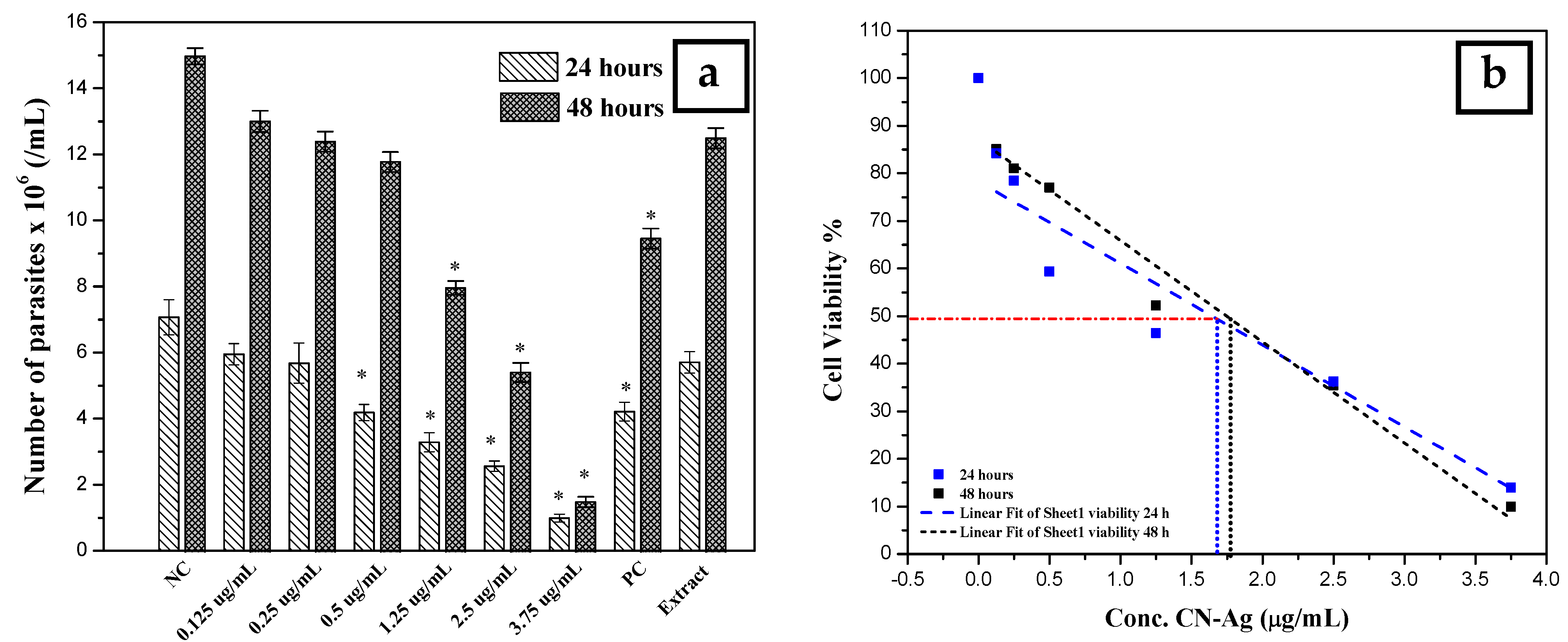
| Samples | Concentration (μg/mL) | Scavenging Ability (%) | IC50 (μg/mL) |
|---|---|---|---|
| CN-Ag | 0.5 | 3.96 ± 0.53 | 9.46 ± 0.59 |
| 1.25 | 5.22 ± 0.22 | ||
| 2.5 | 12.88 ± 0.22 | ||
| 5 | 26.33 ± 0.59 | ||
| 12.5 | 66.37 ± 0.91 | ||
| Ascorbic acid | 1 | 51.90 ± 1.78 | 0.78 ± 0.15 |
| 2 | 59.62 ± 0.92 | ||
| 3 | 71.14 ± 0.81 | ||
| 4 | 85.04 ± 0.52 | ||
| 5 | 85.88 ± 1.03 |
Publisher’s Note: MDPI stays neutral with regard to jurisdictional claims in published maps and institutional affiliations. |
© 2022 by the authors. Licensee MDPI, Basel, Switzerland. This article is an open access article distributed under the terms and conditions of the Creative Commons Attribution (CC BY) license (https://creativecommons.org/licenses/by/4.0/).
Share and Cite
Zein, R.; Alghoraibi, I.; Soukkarieh, C.; Alahmad, A. Investigation of Cytotoxicity of Biosynthesized Colloidal Nanosilver against Local Leishmania tropica: In Vitro Study. Materials 2022, 15, 4880. https://doi.org/10.3390/ma15144880
Zein R, Alghoraibi I, Soukkarieh C, Alahmad A. Investigation of Cytotoxicity of Biosynthesized Colloidal Nanosilver against Local Leishmania tropica: In Vitro Study. Materials. 2022; 15(14):4880. https://doi.org/10.3390/ma15144880
Chicago/Turabian StyleZein, Raghad, Ibrahim Alghoraibi, Chadi Soukkarieh, and Abdalrahim Alahmad. 2022. "Investigation of Cytotoxicity of Biosynthesized Colloidal Nanosilver against Local Leishmania tropica: In Vitro Study" Materials 15, no. 14: 4880. https://doi.org/10.3390/ma15144880
APA StyleZein, R., Alghoraibi, I., Soukkarieh, C., & Alahmad, A. (2022). Investigation of Cytotoxicity of Biosynthesized Colloidal Nanosilver against Local Leishmania tropica: In Vitro Study. Materials, 15(14), 4880. https://doi.org/10.3390/ma15144880








